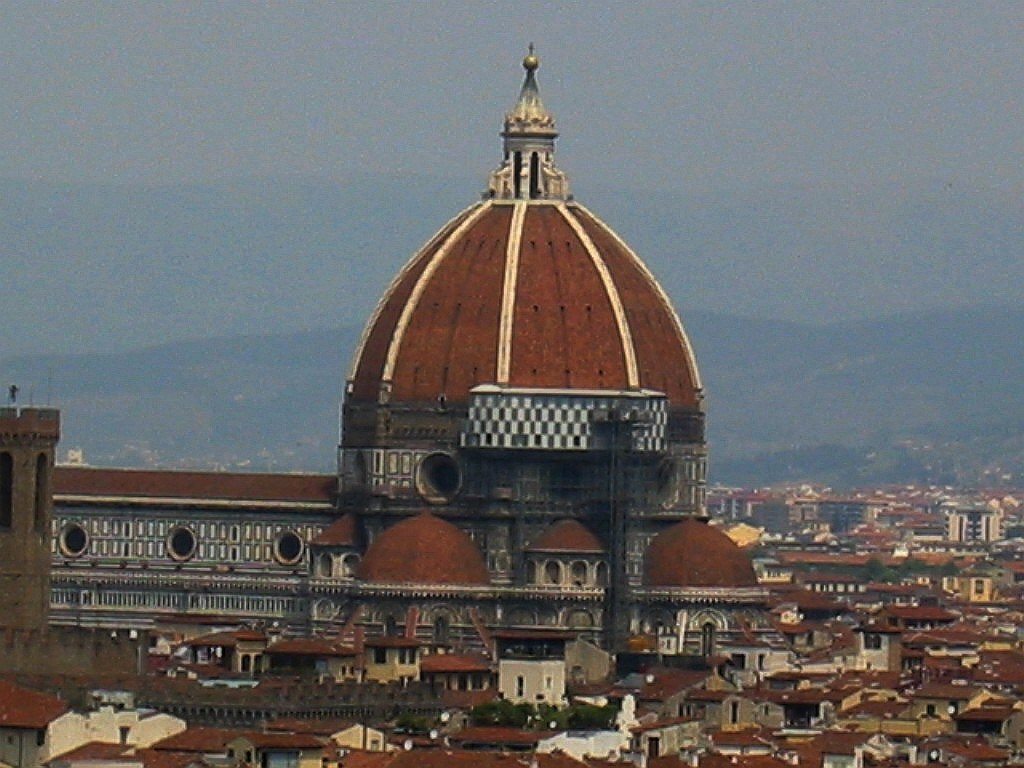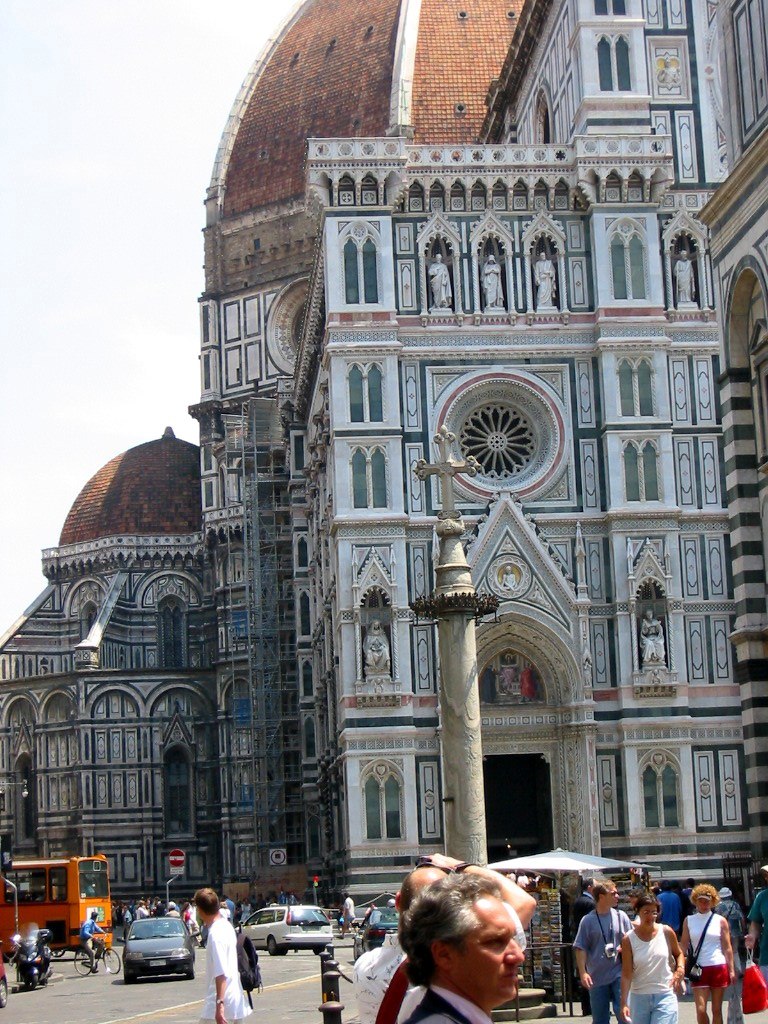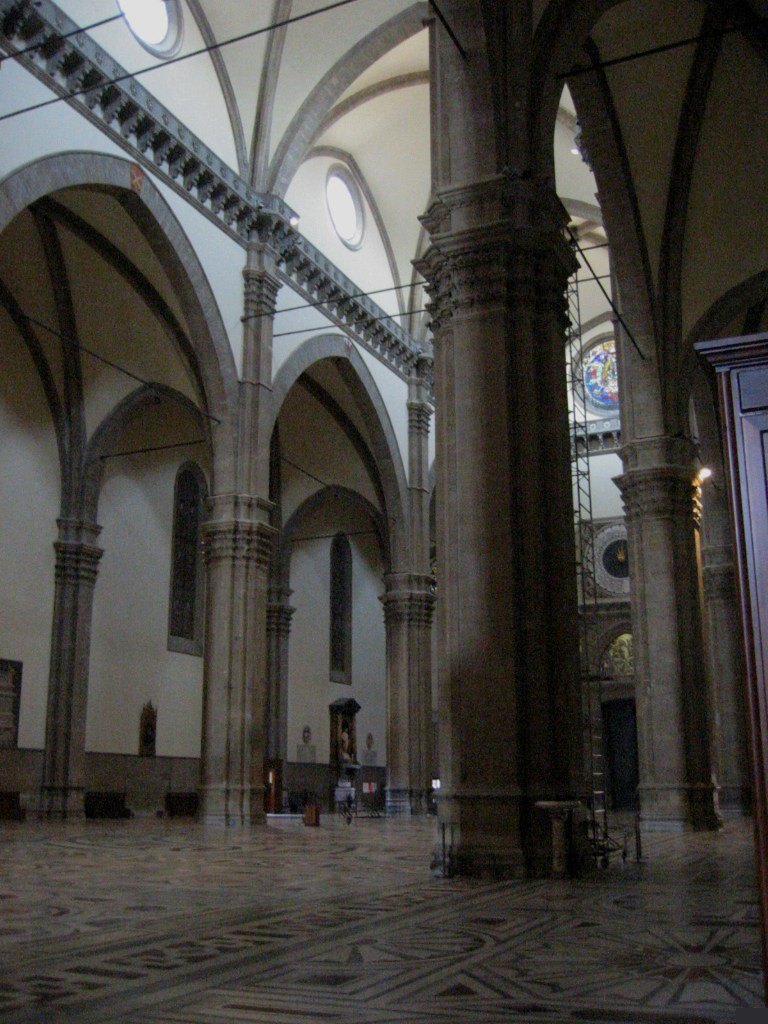
Florence Duomo or Santa Maria del Fiori Cathedral
The dome of the Santa Maria del
Fiori cathedral
dominates Florence's skyline, and is perhaps the sight most
commonly
associated with the city. The cathedral itself is centrally
located on
the
Piazza del Duomo, and is
directly
across from the Battistero;
the
Campanile tower serves
as the bell
tower for the Duomo. It was built at the end of the 13th
century on
the ruins of the 7th century Santa
Reparata, and the ruins of the former church can still
be seen in the crypt. The photo to the right shows the entrance
to the Duomo,
just across the piazza from the east gates of the Battistero.
Like the adjacent
Campanile, the Duomo is also decorated in pink,
white and
green marble. Given its size and the proximity of other
buildings, it
is difficult to get a sense of the size of the Duomo
from
photographs. The people in the photograph to the left gives one
some
idea of the height and width of the cathedral, while the photo
to the
right affords some view as to both the depth of the structure as
well
as its size, relative to the tour group pictured. The photo at
the
bottom left is shot from the opposite side of the Dumo;
it
shows the
 elaborate
construction of the apse area, with the dome supported by
buttresses
and a series of smaller domes. Of course, the main attraction is
the
dome itself, built by Filippo Brunelleschi in 1418.
Brunelleschi, the
winner of a design contest for the project, modeled the dome on
the
Pantheon in Rome. The ingenious herringbone brickwork required
no
scaffolding, and the egg-shaped dome is supported by eight white
ribs.
Visitors can climb its narrow 463 steps to get an unparalleled
view of
Florence. To the right is a view to the west from the Duomo;
visible in
the enlarged picture is the church of San Lorenzo, the Medici
Chapel,
as well as Santa Maria Novella. An exhausting climb, but well
worth it!
elaborate
construction of the apse area, with the dome supported by
buttresses
and a series of smaller domes. Of course, the main attraction is
the
dome itself, built by Filippo Brunelleschi in 1418.
Brunelleschi, the
winner of a design contest for the project, modeled the dome on
the
Pantheon in Rome. The ingenious herringbone brickwork required
no
scaffolding, and the egg-shaped dome is supported by eight white
ribs.
Visitors can climb its narrow 463 steps to get an unparalleled
view of
Florence. To the right is a view to the west from the Duomo;
visible in
the enlarged picture is the church of San Lorenzo, the Medici
Chapel,
as well as Santa Maria Novella. An exhausting climb, but well
worth it!

 The
interior of the Duomo
is in stark contrast to its colorful and ornate interior. (this
is
partly a function of practicality, as many of the treasures of
the Duomo
are now housed next door in the Museo dell'Opera del Duomo)
Two
rows of column support a vaulted ceiling, and the floor space is
empty
and open from the entrance to the dome area where the altar is
located. The photo to the left shows the church looking from the
altar
toward the entrance, while the photo to the right shows the
altar area,
centered beneath Brunelleschi's dome. Midway through the ascent
to the
dome it is possible to get a glance at the Vesari frescoes that
decorates the dome's interior with its scenes from the last
judgment.
The frescoes are pictured in the photo below lefit, while a view
from
the dome is captured in the photo to the right. Also in the
Duomo
complex is the Museo del Opera
del Duomo, a
museum containing over 750 works of art, including the original
Ghiberti's Gates of Paradise, and a Pieta that Michelangelo
designed
for his own tomb.
The
interior of the Duomo
is in stark contrast to its colorful and ornate interior. (this
is
partly a function of practicality, as many of the treasures of
the Duomo
are now housed next door in the Museo dell'Opera del Duomo)
Two
rows of column support a vaulted ceiling, and the floor space is
empty
and open from the entrance to the dome area where the altar is
located. The photo to the left shows the church looking from the
altar
toward the entrance, while the photo to the right shows the
altar area,
centered beneath Brunelleschi's dome. Midway through the ascent
to the
dome it is possible to get a glance at the Vesari frescoes that
decorates the dome's interior with its scenes from the last
judgment.
The frescoes are pictured in the photo below lefit, while a view
from
the dome is captured in the photo to the right. Also in the
Duomo
complex is the Museo del Opera
del Duomo, a
museum containing over 750 works of art, including the original
Ghiberti's Gates of Paradise, and a Pieta that Michelangelo
designed
for his own tomb.